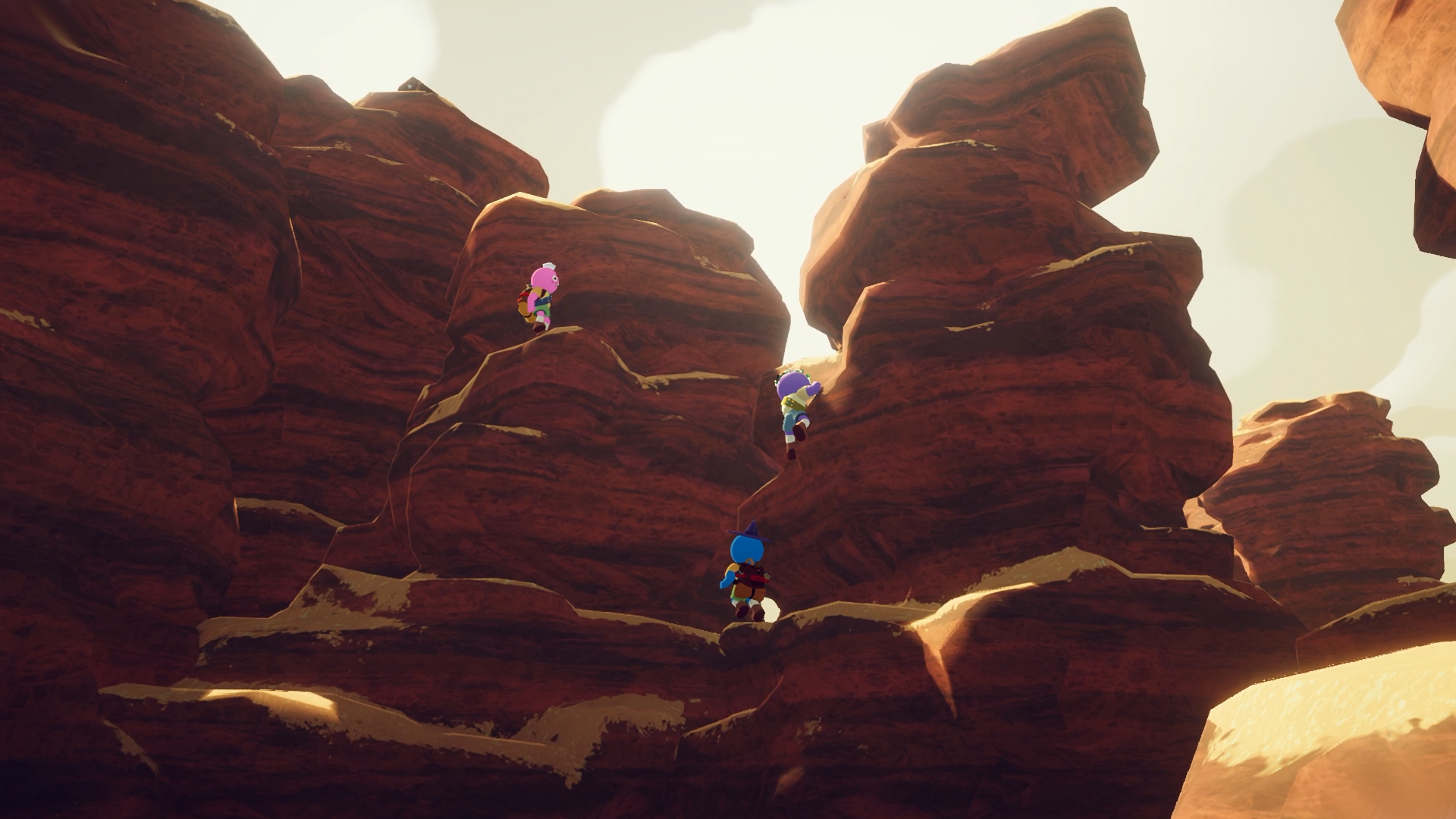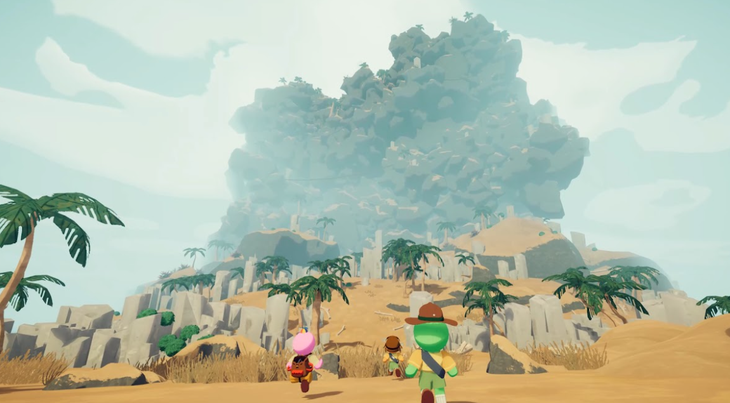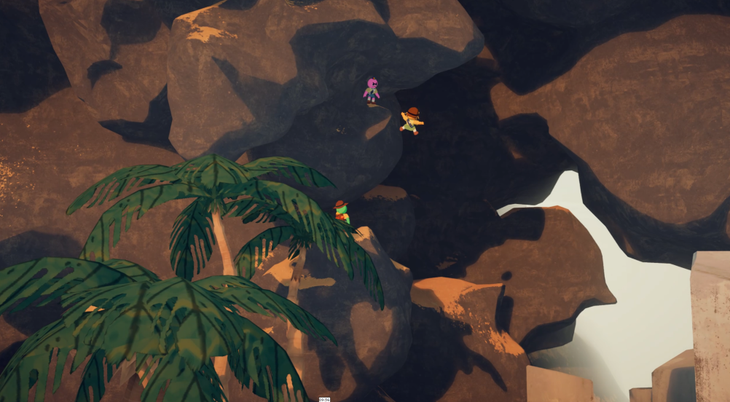This New Video Game Finally Gets Climbing Right

(Photo: Courtesy Landfall)
The wall seems overhung in all directions and the safest line is uncertain. My energy levels are low, and to make matters worse, it’s getting cold and the sun is about to set. My stomach rumbles as I look down into the yawning abyss. where I can hear my partner’s voice echoing off the walls, asking with concern whether we’re off-route.
A scene like this may feel familiar to many alpinists. Except I’m not in the Alps, Himalayas, or Andes. There are snacks within arm’s reach, and a warm blanket on my lap. I can hear the rain tapping at the window. I’m playing the new climbing video game: Peak. The objective is as you would expect: reach the top of the tallest mountain.
Unique among the world’s greatest sports, climbing has never really had its own iconic video game. Soccer has FIFA, American Football has Madden, and NASCAR has Mario Kart, each with their own obsessive following. As climbers and mountaineers, we’ve always had to make do with the real thing. This means the weary, the injured, and the rained-on are all denied their fix.
Well, those days might be done. Thanks to this quirky game released in June from Swedish developers Landfall, you might be able to scratch that climbing itch from home.
Our Picks

It’s not to say that climbing hasn’t featured at all in the gaming world. Beloved titles have put real effort into integrating climbing as a gameplay mechanic. We’ve seen Link scale massive mountains in Tears of The Kingdom, and cathedral-topping acrobatics in the Assassin’s Creed series. But climbing remains incidental to these games. It’s just a means by which you reach new areas to encounter a boss fight, items, or a puzzle. In Peak, we have a promising contender for the game many of us have been waiting for.

Why other climbing video games fail
Before we get into Peak, I must acknowledge that there is another category of games where climbing is the sole focus. I call these games “hand and foot positioning simulators.” Take the descriptively named New Heights: Realistic Climbing and Bouldering, for example. A player takes their time precisely moving one appendage from one gray 3D scanned feature to the next. Do this repeatedly for around five minutes and your avatar has reached the top.
Another game called Cairn (currently in demo) is visually gorgeous. With beautiful vistas and elegant movement style, it had me excited. But after actually playing it, I found that Cairn merely magnifies the mundane. You carefully move hands and feet to various grey polygons in search of upward movement, chalking up and shaking out as you slowly go. Developers have even tried doing it in VR with The Climb, but the formula is exactly the same.
What’s the problem with climbing games that faithfully recreate the biomechanics of climbing on screen? Sadly, playing them feels like donkey work. While they may represent the Euclidean form of rock climbing that you’d use to explain to an alien visitor (or your dad) “what it is,” the experience of performing it on a computer via repetitive clicks feels grim. Games that attempt to slowly, closely simulate climbing one move at a time feel a million miles away from real rock climbing—or from being a fun game.
A journey that will thrill climbers

Peak takes a different approach. Instead of focusing on rendering drop knees and 3D-scans of the Verdon Gorge, they took some of the core ingredients of climbing, then added whacky twists and perils to heighten interest.
Upon starting the game, the player finds themselves in the role of one of several scouts, played by up to three of your friends. Your small airplane has crash landed on a mysterious island. Thankfully, a helpful guidebook from a mysterious scoutmaster informs you that the only way to escape is up. You must climb the highest nearby peak to light flares and await rescue. (Note: If by some misfortune you happen to be in this situation in real life, the FAA’s advice is to stay near the wreckage!).
From the smoking crash, you can see the first peak towering above you. But what you can see is only the beginning. The climb takes you from ledge to ledge, over desert towers, up overhangs amid rain showers, and across dizzying Tyrolean traverses. All the while, you battle fatigue, hunger, and poisonous plants.

Designed for re-playability and with cooperation in mind, the game is great at creating moments of hilarity or tension. The cliffs of the game are regenerated at 1pm Eastern Time every day, so no two trips are quite the same. And the proximity chat means that friends who are close actually sound close, while friends who are far away sound far. This adds significantly to the atmosphere.
You may experience the sorrow of seeing a friend somehow miss a jump you just nailed, their anguished cries fading away into the mist as they tumble down the cliff. And the dreaded pump is as real in Peak as in real life. But since Peak is not real life, some players give over to their intrusive thoughts. One might deliver a banana peel, sending you skidding off a ledge. Or they could fiendishly lob a coconut at your head, just as you reach a cliff’s edge. But the game rewards comradely play. Some players make it to the summit of the peak, only to grow too weak with hunger to go on. The only way is for a friend to carry you Samwise Gamgee-style to a mountaintop rescue. Like real climbing, it’s at times frustrating, at times utterly cinematic.
Peak video game: My verdict

Peak doesn’t simply ask “What if you were climbing, but on a computer?” Instead, it asks “What if you were climbing in a race against a deadly frozen fog that will kill you if you falter?” Furthermore, it offers the novel ascension methods of human cannons, chain guns, or a strange “anti-rope” to assist with your ascent. And what if there were malevolent supernatural consequences for breaking Rule Zero of the game—that one should never ever abandon a friend in need?
By answering the questions we didn’t know needed answering and inventing options we never knew we were missing, this video game creatively builds on the world of climbing, rather than just digitally replicating it. The adventures it facilitates in the vertical plane are a near-endless source of shenanigans and stoke.
If you’re one of the weary, the rained-on, or the injured—or if it’s just your rest day—hit up some friends and give it a try. In an age of $100-plus cams, there aren’t that many ways you can squeeze more fun out of $7.99.
You can find Peak on Steam, or if you use macOS, you can play using this guide.



